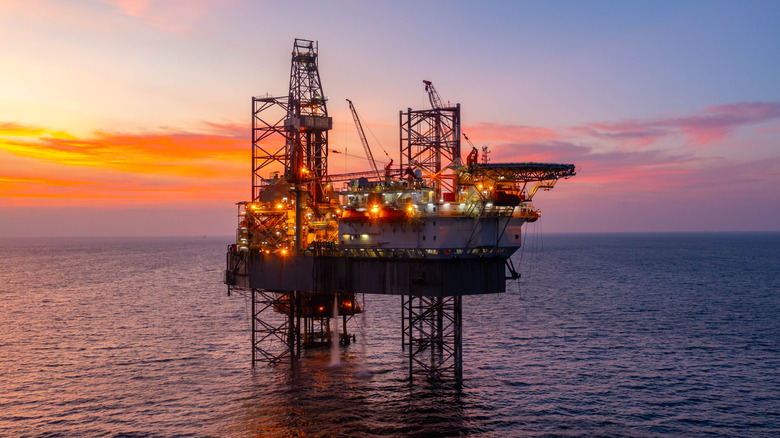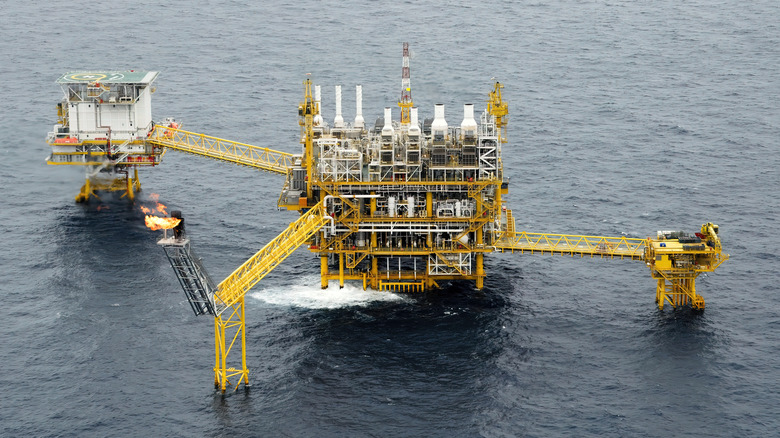Do Offshore Oil Rigs Float? Here's How They Stay In Place
Off-shore oil drilling currently accounts for over 35% of the world's total oil production, and that number has consistently risen over recent history. While a majority of oil extraction takes place on land, that's still a significant amount of oil being extracted in the ocean, despite the environmental concerns of offshore drilling. There are three different types of offshore drilling operations, categorized by how deep into the water they need to go.
Shallow water production operations are any offshore oil drilling facilities that drill in water depths of 400 meters or less, or about 440 yards. Deepwater oil production begins below the 400-meter mark and goes down to 1500 meters, which is nearly one mile below the surface of the water. Any offshore oil rig that extends past 1500 meters is considered to be an ultra-deepwater production facility. However, that's still nowhere close to the deepest man has explored in the ocean.
As for how these massive facilities stay above the water and in one place, each of the three categories of offshore oil drills go about it in slightly different ways. Offshore floating oil rigs stay afloat by using buoyancy, the pressure exerted by water that keeps it floating. Oil rigs achieve this by displacing water with enough buoyant force to keep it all afloat. The rigs are able to displace water by using massive, hollow legs that serve as pontoons. There are also sections built into the rig that are filled with air to help improve buoyancy.
Some offshore oil rig facilities are attached to fixed constructions that reach down to the seabed, though this is limited by the depth of the water. Other options include floating operations that can rely on anchored ships, floating operations that don't use ships but an anchored platform, and systems that stay on the sea floor.
The different forms of flotation
With the ability to reach depths of about 450 meters, fixed platforms most closely resemble a large electrical wire tower. The upper reaches of the fixed platforms feature a deck with space for living quarters, the drilling rig itself, and facilities for oil production. Out of the seven major types of offshore oil drill rigs, the fixed platform is the most affordable.
Compliant towers are similar to fixed platforms, though the structure is stronger and able to withstand the large forces of waves. Capable of being used at depths of 610 meters and above, compliant towers have large decks at their tops for crew quarters and all oil drill operations.
Mini-Tension Leg Platforms, also known as Sea Stars, are floating platforms with extended legs near their bottoms. Those legs are then attached to anchor points in the seabed to stabilize the rig. This rig was first used in 1998 in the Gulf of Mexico, and can also be used as temporary rigs before a more permanent offshore oil rig is installed.
Larger Tension Leg Platforms are also used, featuring a floating structure that's attached to the seabed via high-tension cables. These systems have been used in depths of over 1000 meters.
The two most unique offshore oil rigs are subsea systems and spar platforms. Subsea systems are, as you may guess, below the water line and sit on the sea floor. Using a moveable rig, the wells are drilled and pass gas and oil via pipelines to a production platform. Subsea systems can be used at depths of up to 2100 meters. Spar platforms are the largest type of offshore oil rig and can also reach the furthest down. Using a large cylinder in the center to help stabilize the platform from severe weather, there are also cables and lines that attach to the sea floor.

